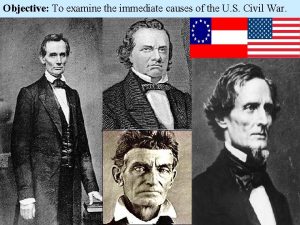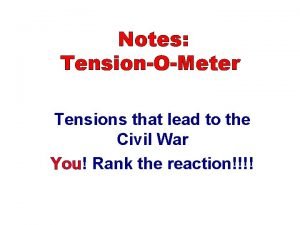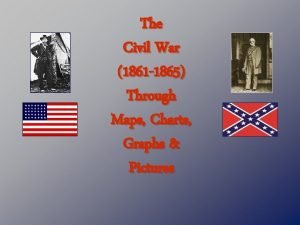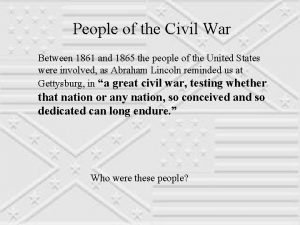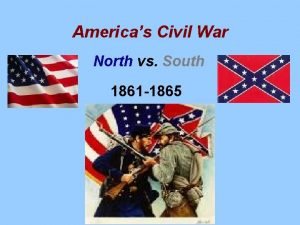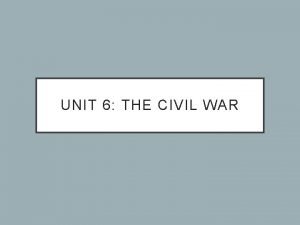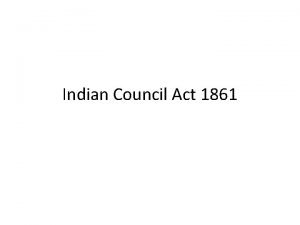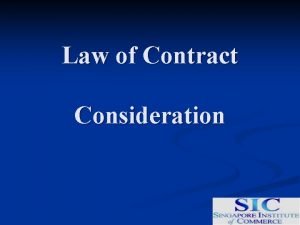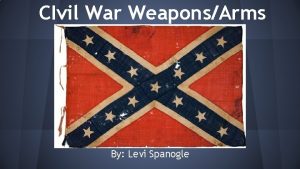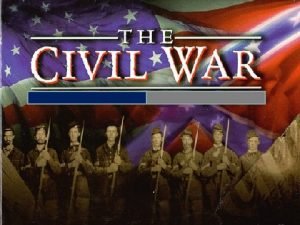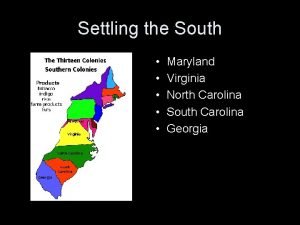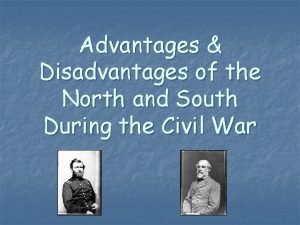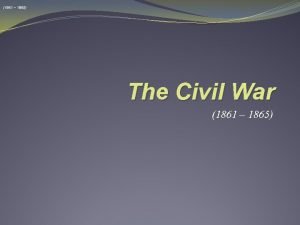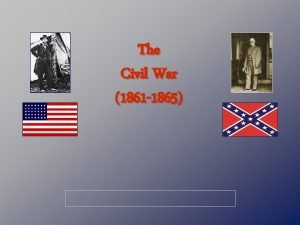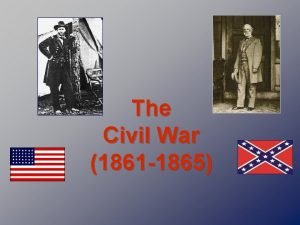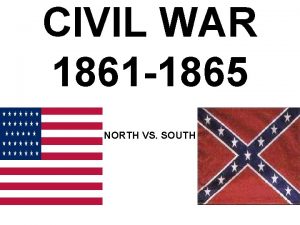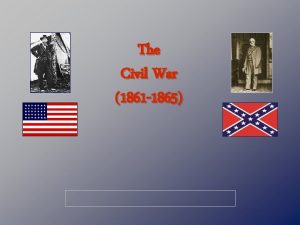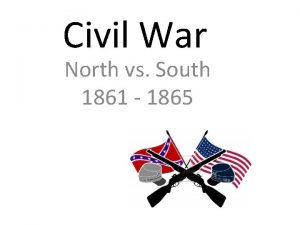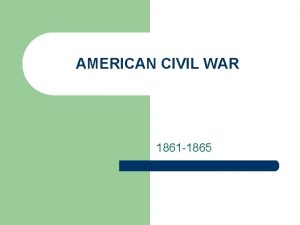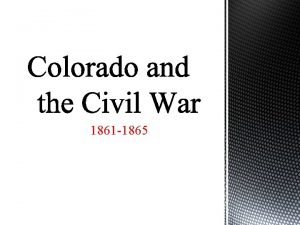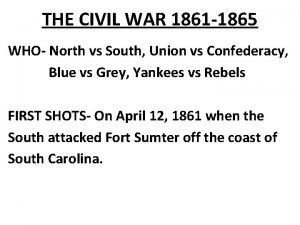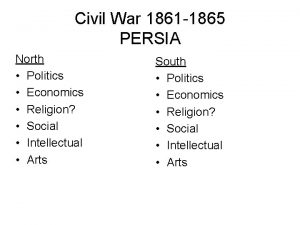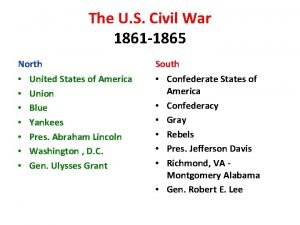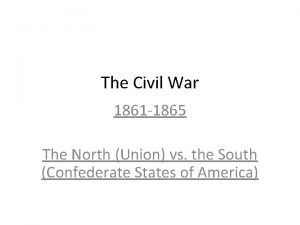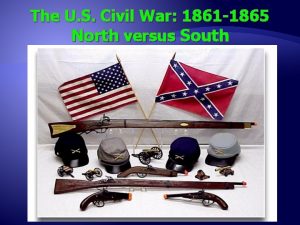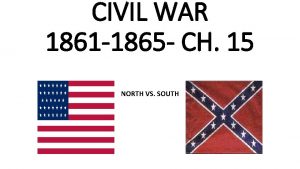North and South At War 1861 1865 PAGEANT

















- Slides: 17

North and South At War 1861 -1865 PAGEANT CHAPTER 20

Things You Need To Know North = United States, Union, Federal – blue uniforms South = Confederate States, Confederacy, Rebels – gray uniforms

The United States - 1861

1 a. Lincoln, Fort Sumter, and War Aims 1861 – The South has seceded from the Union and formed the Confederate States of America Abraham Lincoln is president; his view: Secession is illegal The Confederate States of America is not a legitimate country but U. S. states in rebellion and thus cannot be negotiated with Lincoln felt that if the minority South were allowed to break up the Union, it would shatter the purpose of the Constitution and destroy the purpose of a free government. Lincoln was adamant about not firing first; he didn’t want to be the aggressor in a war against his own people The South relieved Lincoln of this worry when they fired first Fort Sumter – Fighting begins when Confederates fire upon a Federal fort in Charleston, South Carolina in April 1861 containing Union soldiers who refused to leave – this begins the military engagement

1 b. Lincoln, Fort Sumter, and War Aims The war has begun – Lincoln calls up volunteers to put down the “Southern insurrection (rebellion)” Soon after, Virginia, Arkansas, Tennessee and North Carolina secede – the Confederacy now has 11 states officially though it will claim 13 (Missouri and Kentucky) Lincoln’s main concern was keeping the Union together, and he nearly lost the slave holding border states of Maryland, Kentucky, Delaware, Missouri, and West Virginia – He couldn’t risk them seceding too… The border states were states that bordered the Union (North). Lincoln allowed them to keep their slaves in if they didn’t secede Lincoln stated that his war aim was to preserve the Union and not to interfere with slavery. This appealed to the border states.

The United States - 1861

2. Balance of Forces Strengths of both sides North – more troops, bigger population, more RR, had 85% of the nation’s industry, stable government, Abraham Lincoln South – better military leadership, and easier strategy – they just had to defend their territory not invade Union strategy had 3 parts 1) Blockade the southern coast – nothing goes in, nothing comes out 2) Take control of the Mississippi River and divide the South 3) Take the Confederate capital city of Richmond, Virginia

3 a. Foreign Involvement How did Europe react to the war? 1) Aristocracy – The rich in Europe sided with the South; they had disdain for American democracy and sided with Southern aristocracy 2) Masses – Europe’s working class people pulled for the North, the end of slavery, and the triumph of free popular government

3 b. Foreign Involvement Though the Civil War was between Americans, diplomacy was an important factor The South wanted help from Britain and France Lincoln needed to prevent that Britain came close to getting involved twice: 1) The Trent Affair – where a Union ship stopped an English ship and removed two Confederate diplomats in late 1861 2) Britain also was willing to build ships for the Confederacy; notably the Alabama, which conducted raids against Union ships until it was destroyed in 1864

4 a. Lincoln and Liberties Abraham Lincoln (U. S. ) vs. Jefferson Davis (C. S. A. ) The best way to compare the two is to compare steel and iron. Both were strong but… Lincoln was like steel, flexible but firm when needed and still unbreakable Davis was like iron, strong but unwilling to bend Lincoln knew what to work around and what not to compromise on Because he saw the United States as in a state of rebellion, he used what he called “emergency powers”, powers that were actually unconstitutional 1) Suspending habeas corpus – Lincoln suspended the right to not be imprisoned w/o trial; throwing Northern supporters of the Confederacy in jail and keeping them there indefinitely 2) Lincoln also had editors of anti-war newspapers arrested and suspended their newspapers

Jefferson Davis President of the Confederacy

President Abraham Lincoln

4 b. Lincoln and Liberties Between the North and the South, the North had the most people to pull from when it came to drafting soldiers Draft laws weren’t the fairest The war was a “rich man’s war but a poor man’s fight” North – Rich young men could send substitutes for themselves off to the war; exemption could be purchased for $300 ($5, 700 today) South – Slave owners of more than 20 slaves could claim exemption from fighting the war.

5 a. Economic Aspects of the War The North was better able to pay for fighting the war. 1) Taxes and tariffs – The North relied on raising taxes and tariffs to increase revenue while the South could never agree on a Confederate national tax or tariff 2) Bonds and Borrowing – With a larger population and economy, the North also benefitted from selling war bonds and borrowing 3) Printing Money – Both the Union and the Confederacy suffered inflation from printing paper money; the Union suffered a 80% inflation rate, but the South suffered a 9, 000% inflation rate

5 b. Economic Aspects of the War After the war, the North and the South came out economically quite different: 1) North – A massive growth of factories during wartime led to a major economic boom. 2) South – the Union blockade and destruction of Southern property left the South in shambles.

Union vs. Confederacy

5 b. Economic Aspects of the War Women also played a part in the war The “caring professions” Clara Barton risked her life during the war to treat soldiers She transformed the nursing profession
 South carolina 1861
South carolina 1861 Tensionometer
Tensionometer Civil war 1861/1862
Civil war 1861/1862 Civil war 1861/1862
Civil war 1861/1862 Chapter 14 lesson 2 north and south
Chapter 14 lesson 2 north and south North and south states civil war
North and south states civil war North and south states civil war
North and south states civil war Chapter 20 girding for war the north and the south
Chapter 20 girding for war the north and the south Civil war causes
Civil war causes North vs south civil war
North vs south civil war Indian councils act 1861
Indian councils act 1861 Unionistička stranka 1861
Unionistička stranka 1861 Hartley v ponsonby
Hartley v ponsonby Springfield model 1861 rifle facts
Springfield model 1861 rifle facts Anaconda plan
Anaconda plan Imaginary lines of the earth
Imaginary lines of the earth Maryland, virginia, north carolina, south carolina, georgia
Maryland, virginia, north carolina, south carolina, georgia Advantages and disadvantages of the north and south
Advantages and disadvantages of the north and south
